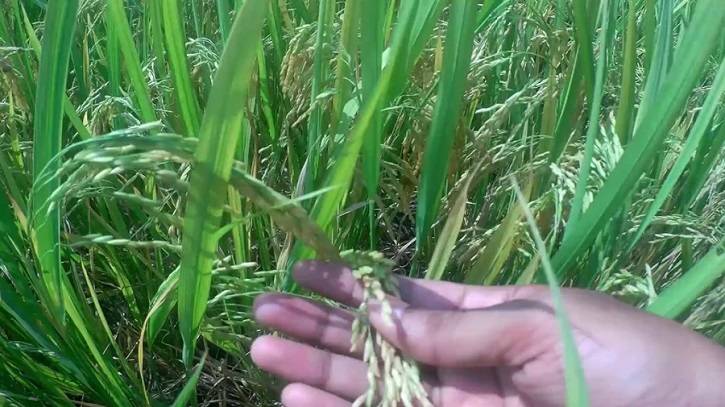Important genetic properties to soon help rice breeders
Also grows in India and Pakistan
The saline heavy soils of southern Bangladesh account for 25% of the country’s total cultivated land. High salinity levels in the soil of the coastal belt, characterized by brackish waters, have long been posing a serious threat to the country’s food security, with millions of farmers in southern Bangladesh facing the challenge of low rice productivity.
A team of scientists, who have been working on a wild rice – Uridhan (Oryza coarctata) – for several years, have finally come up with a breakthrough to fight coastal soil salinity and help farmers grow more rice from the vast salt flats of southern Bangladesh.
They have found out some important genetic properties in Uridhan that would soon help rice breeders develop varieties and rice growing protocols, expected to help farmers in the south conquer the current barriers posed by high salinity in the paddy lands there.
Under the initiative, funded by the Bangladesh Climate Change Trust, the scientists have successfully introduced three genes from the wild rice to some of Bangladesh’s otherwise saline-susceptive but most productive modern rice varieties. Inlab conditions, they have received good results in terms of their new-found capability to withstand high degrees of soil salinity.
The government’s agro-biotech regulatory authorities have just recently given approval for these transgenic rice lines to go under greenhouse trials at the facility of the National Institute of Biotechnology (NIB).
Prof Zeba Islam Seraj, who teaches biochemistry and molecular biology at the University of Dhaka, has been leading the team of scientists working on Uridhan. Late last week, she was making a presentation on the research outcome in front of an audience representing the scientific community at the University of Dhaka.
Speaking to this correspondent on the sideline of the event, Professor Zeba said: “Coastal agriculture of Bangladesh is highly vulnerable to climate change and natural disasters. The intensity of disasters like sea level rise, tidal surge, soil salinity, salt water intrusion and cyclones in the coastal belt are increasing day by day. Rice cultivation in the coastal belts is becoming difficult due to an increase in soil salinity.”
That’s why, she said, solutions to the increasing problem of salinity involve several different approaches such as improved water management, agricultural utilization of halophytic species and breeding approaches to develop salt tolerant crops.
According to Prof Zeba, they have found in Uridhan the characteristics that allow it to show considerable adaptation to high salinity (20–40 dS/m) and can also tolerate complete submergence in saline water for a long period. The importance of O. coarctata (Uridhan), the wild halophytic relative of rice, has been recognized as an important source of genes for the improvement of rice via biotechnological approaches.
Prof Zeba and her team have field tested the Uridhan’s capacity to desalinate saline water and they’ve successfully grown otherwise saline-susceptive modern rice varieties in several coastal districts by using such desalinated water as irrigation.
“We repeated the same experiments in the field in Khulna, Satkhira and Noakhali, where we used
Uridhan treated water of low salinity to irrigate rice fields. These experiments showed that the
yield of rice increased two times compared to fields irrigated with river water.”
Prof Zeba added: “In future it is suggested that Uridhan can be used to lower the conductivity of stagnant salt water so that it can be used to irrigate rice fields in the Boro season, when river water conductivity becomes higher than 20 dS/m.”
Uridhan grows in saline estuaries of Bangladesh as well as neighboring countries like India and Pakistan.
Some genes of Uridhan have been used to transform modern rice varieties, such as BRRI Dhan 75 and 81, giving them the strength to withstand high salinity.
Prof Zeba said, Uridhan also harbors fungi (which live inside the roots and are called endophytes). “We’ve isolated these fungi and they’ve shown to have plant growth promotion activities under high salt stress.”
When these fungi are applied to plant seeds and soil as biofertilizer, “we have found very promising yield increases in rice under high salt stress,” she added.
Scientists at Bangladesh Rice Research Institute (BRRI) told Dhaka Tribune that given the importance of genetic richness of the wild rice, BRRI has Uridhan variety preserved in their rice gene bank.
Source: Dhaka Tribune.

